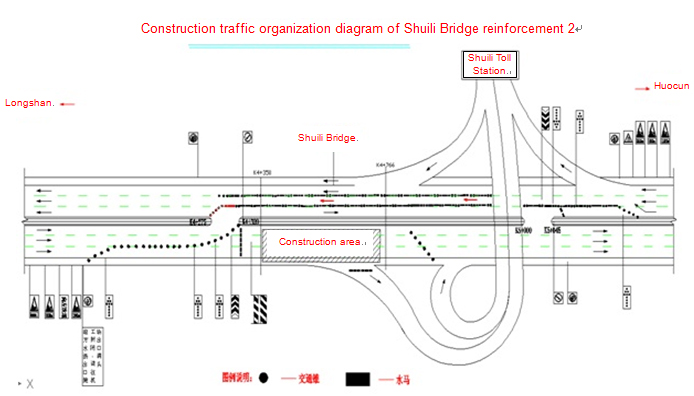Innovative and optimal traffic organization program applied in the reinforcement and maintenance of the Shuili Bridge of the North Second Ring Expressway
The 417m-long Shuili Bridge of the North Second Ring Expressway is based on cast-in-place reinforced concrete continuous box girders. It was found through testing that under prolonged, repeated vehicle loads, the base, web and flange slabs in the superstructure have been cracked to varying degrees. The bridge is rated III, and the fulcrum sections of the box girders of the bridge have insufficient bending resistance and bearing capacity. In order to ensure the safety of the bridge structure, the reinforcement and maintenance of the Shuili Bridge was included in the maintenance plan. In view of the high traffic volume of the North Second Ring Expressway, a meticulous traffic organization program should be developed.
The deck pavement replacement of the Shuili Bridge was constructed all day in a half-closed manner. In order not to impede vehicles passing through the North Second Ring Expressway and minimize the impact of construction on toll collection, we began to discuss the traffic organization program during construction in March 2012. Through repeated discussions among our internal departments and with the traffic police, a traffic organization program with the deck half-closed and the other half open to two-way traffic was finally defined.
For the half deck open to two-way traffic, water barriers and traffic cones were first used to separate the central fast lane from the slow lane, the fast and overtaking lanes designated for one driving direction, and the slow lane and shoulder designated for the other, as shown in Figure 1. The central fast and overtaking lanes were then separated using water barriers and traffic cones. When traffic jam occurred in the direction of the slow lane and shoulder, the central fast lane would be changed to the same driving direction as the slow lane. The former traffic closure would not be restored until the traffic jam was mitigated, as shown in Figure 2. According to statistics, the driving direction of the fast lane was changed about 90 times during the two-month construction period of the Shuili Bridge.

Figure 1 Schematic diagram with central fast and overtaking lanes designated for a unified driving direction

Figure 2 Schematic diagram with driving direction changed for central fast lane
During the half-closed construction of the Shuili Bridge, the opening of the median strip was set as a horn shape to facilitate rapid vehicle passage. Thanks to a dynamic traffic organization program, dynamic on-site command, and the assistance from the staff of different departments, no extensive traffic jam occurred during construction, the project was completed successfully, and the impact of construction on operation and toll collection was minimized.